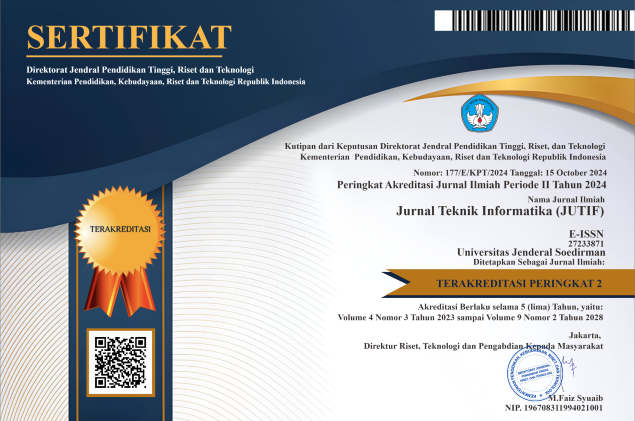Automated Classification of Mungkus Fish Freshness Based on Eye and Gill Images Using the Naive Bayes Algorithm
DOI:
https://doi.org/10.52436/1.jutif.2025.6.4.5146Keywords:
Classification, Fish Freshness, Mungkus Fish, Naïve BayesAbstract
The problem of assessing the freshness of fish, especially Mungkus fish, is usually directed at several physical indicators, such as eye appearance, gill condition, meat quality, and odor. This traditional method is often considered inaccurate and requires certain expertise, therefore a more effective and objective method is needed to assess the freshness level of Mungkus fish, which in turn can provide benefits for both fishermen and the public in general. The solution to this problem by using the Naïve Bayes method in classifying the freshness level of Mungkus fish based on eye and gill images has proven to be a fairly efficient approach. The Naïve Bayes method itself is a simple but very effective algorithm in the field of machine learning, and operates based on Bayes' Theorem with the assumption that features are independent of each other. This method can be applied in the initial stage of classification by utilizing basic features taken from images of fish eyes and gills. Based on testing 30 new data sets, the clustering system demonstrated an accuracy rate of 66.67%, indicating that 20 data sets were correctly classified according to their actual conditions. On the other hand, 10 data sets, or 33.33%, could not be categorized correctly. Of the 30 old data sets tested, the system was able to correctly classify 19 (63.33%), while 11 (36.67%) still had errors in their classification predictions. Overall, the system successfully performed data clustering with 65% accuracy, with the remaining 35% still showing errors in the classification process.
Downloads
References
D. F. Lestari, Sipriyadi, and A. H. Putra, “Morphometric characteristics of mungkus fish (Sicyopterus sp.) from several rivers in Bengkulu Province, Indonesia,” IOP Conf. Ser. Earth Environ. Sci., vol. 869, no. 1, 2021, doi: 10.1088/1755-1315/869/1/012025.
A. H. Putra, D. F. Lestari, and S. Sipriyadi, “Analisis Isi Lambung Ikan Mungkus (Sicyopterus cynocephalus: GOBIIDAE) untuk Menentukan Food and Feeding Habit di Sungai Padang Guci Kaur,” J. Biosilampari J. Biol., vol. 6, no. 1, pp. 1–9, 2023, doi: 10.62112/biosilampari.v6i1.53.
N. Hamron, I. Warman, and D. N. Intan, “DIVERSIFIKASI OLAHAN BERBASIS IKAN MUNGKUS (Sicyopterus chynocepalus) SEBAGAI UPAYA PENINGKATAN EKONOMI MASYARAKAT DI DESA TEBING KANING KECAMATAN ARMA JAYA KABUPATEN BENGKULU UTARA,” J. Pengabdi. Kolaborasi dan Inov. IPTEKS, vol. 2, no. 1, pp. 83–90, 2024, doi: 10.59407/jpki2.v2i1.375.
A. H. Putra, D. F. Lestari, and Sipriyadi, “ Analysis of Water Quality from Several Rivers as Habitat of Mungkus Fish ( Sicyopterus sp.) in Bengkulu Province ,” Proc. 3rd KOBI Congr. Int. Natl. Conf. (KOBICINC 2020), vol. 14, no. Kobicinc 2020, pp. 101–105, 2021, doi: 10.2991/absr.k.210621.017.
I. B. Akbar and S. Subandrio, “The Influence Of Promotions And Price Perceptions On Consumer Buying Interest ( Case Study Sale Mungkus Fish Curry At Home Eat Field Jar Regency Kaur ),” Bengkulu Int. Conf. Econ. Manag. Bus. Account., vol. 2, pp. 899–908, 2024, doi: 10.33369/bicemba.2.2024.101.
V. A. Corneles and C. Darwin, “DIVERSITY OF FISH TYPES IN THE WIDE WATERS OF KAUR DISTRICT RIVER,” pp. 3935–3947, 2025.
A. Mariono, S. Handayani, and Y. I. Ariska, “Marketing Strategy Of Ayiak Nelengau Food Hotel In Bengkulu Selatan,” J. Ekon. Manaj. …, pp. 66–73, 2021, [Online]. Available: https://penerbitadm.com/index.php/JURNALEMAK/article/view/51%0Ahttps://penerbitadm.com/index.php/JURNALEMAK/article/download/51/75
U. Jenderal and A. Yani, “Jurnal Kesehatan Prima 2012.Compressed.Pdf,” vol. 16, no. 1, pp. 25–33, 2022.
N. Pasisingi, D. Suci, C. Panigoro, and M. K. Kadim, “Morphological characteristic and truss morphometric analysis of amphidromous goby (‘nike’) (Teleostei: Gobiiformes) in Bone River, Gorontalo, Indonesia,” Biodiversitas, vol. 25, no. 1, pp. 223–231, 2024, doi: 10.13057/biodiv/d250125.
W. Subchan, V. E. Susilo, Y. Khairiyah, G. Wahyudewantoro, S. Ariyunita, and A. Rohman, “The diversity of freshwater fish in sanenrejo and wonoasri river resorts from meru betiri national park,” J. Phys. Conf. Ser., vol. 1832, no. 1, 2021, doi: 10.1088/1742-6596/1832/1/012009.
M. Muchtar, Y. P. Pasrun, R. Rasyid, N. Miftachurohmah, and M. Mardiawati, “Penerapan Metode Naïve Bayes Dalam Klasifikasi Kesegaran Ikan Berdasarkan Warna Pada Citra Area Mata,” J. Inform. dan Tek. Elektro Terap., vol. 12, no. 1, pp. 611–617, 2024, doi: 10.23960/jitet.v12i1.3879.
Z. L. R. Nafi and Muh. Syarif Hidayatullah, “Deteksi Kesegaran Ikan Nila Menggunakan Convolutional Neural Networks Berbasis Citra Digital,” JIMUJurnal Ilm. Multidisipliner, vol. 2, no. 03, pp. 608–615, 2024, doi: 10.70294/jimu.v2i03.413.
C. Cakra, S. Syarif, H. Gani, and A. Patombongi, “Analisis Kesegaran Ikan Mujair Dan Ikan Nila Dengan Metode Convolutional Neural Network,” Simtek J. Sist. Inf. dan Tek. Komput., vol. 7, no. 2, pp. 74–79, 2022, doi: 10.51876/simtek.v7i2.138.
S. Sipriyadi, A. H. Putra, and D. P. Lestari, “Distribusi Coliform dan Escherichia Coli dari Beberapa Sungai Di Provinsi Bengkulu,” Org. J. Biosci., vol. 1, no. 2, pp. 99–108, 2021, doi: 10.24042/organisms.v1i2.10842.
M. Sholihin, “Identifikasi Kesegaran Ikan Berdasarkan Citra Insang dengan Metode Convolution Neural Network,” JATISI (Jurnal Tek. Inform. dan Sist. Informasi), vol. 8, no. 3, pp. 1352–1360, 2021, doi: 10.35957/jatisi.v8i3.939.
A. Prasetyo, F. Masykur, A. R. Yusuf, A. Y. Astuti, and I. Abdurrozzaq, “Analisis Deteksi Citra Mata Ikan Nila dengan Metode Convolutional Neural Network Arsitektur Alexnet,” vol. 5, no. 1, pp. 48–53, 2025.
H. Honainah, F. F. Romadhoni, and A. Ato’illah, “Klasifikasi Kesegaran Ikan Tongkol Berdasarkan Warna Mata Menggunakan Metode Backpropagation,” J. Penelit. Inov., vol. 2, no. 2, pp. 405–414, 2022, doi: 10.54082/jupin.90.
A. Saleh, “Implementasi Metode Klasifikasi Naïve Bayes Dalam Memprediksi Besarnya Penggunaan Listrik Rumah Tangga,” Creat. Inf. Technol. J., vol. 2, no. 3, pp. 207–217, 2015.
G. Parthiban, A. S.K.Srivatsa, and A. Rajesh, “Diagnosis of Heart Disease for Diabetic Patients using Naive Bayes Method,” Int. J. Comput. Appl., vol. 24, no. 3, pp. 7–11, 2011, doi: 10.5120/2933-3887.
O. Kramer, “Dimensionality Reduction with Unsupervised Nearest Neighbors,” Intell. Syst. Ref. Libr., vol. 51, pp. 13–14, 2013, doi: 10.1007/978-3-642-38652-7.
C. Y. Jerandu, P. Batarius, and A. A. J. Sinlae, “Identifikasi Kualitas Kesegaran Ikan Menggunakan Algoritma K-Nearest Neighbor Berdasarkan Ekstraksi Ciri Warna Hue, Saturation, dan Value (HSV),” Build. Informatics, Technol. Sci., vol. 4, no. 3, pp. 1536–1547, 2022, doi: 10.47065/bits.v4i3.2613.
G. D. K. Sandi, D. Syauqy, and R. Maulana, “Sistem Pendeteksi Kesegaran Ikan Bandeng Berdasarkan Bau Dan Warna Daging Berbasis Sensor MQ135 Dan TCS3200 Dengan Metode Naive Bayes,” J. Pengemb. Teknol. Inf. dan Ilmu Komput., vol. 3, no. 10, pp. 10110–101117, 2020.
S. Dhanabal and S. Chandramathi, “A Review of various k-Nearest Neighbor Query Processing Techniques,” Int. J. Comput. Appl., vol. 31, no. 7, pp. 14–22, 2011, [Online]. Available: http://scholar.google.com/scholar?hl=en&btnG=Search&q=intitle:A+Review+of+various+k-Nearest+Neighbor+Query+Processing+Techniques#0
E. D. Hartono, C. Y. Priyanto, and A. Kridoyono, “Analisis Ekstraksi Fitur Dan Roi ( Region of Interest ) Dalam Menentukan Kesegaran Ikan Bandeng Menggunakan Gray Level Co-Occurance Matrix,” vol. 2, no. 1, pp. 1–14, 2025.
U. S. Rahmadhani and N. L. Marpaung, “Klasifikasi Jamur Berdasarkan Genus Dengan Menggunakan Metode CNN,” J. Inform. J. Pengemb. IT, vol. 8, no. 2, pp. 169–173, 2023, doi: 10.30591/jpit.v8i2.5229.
E. Rasywir, R. Sinaga, and Y. Pratama, “Analisis dan Implementasi Diagnosis Penyakit Sawit dengan Metode Convolutional Neural Network (CNN),” Paradig. - J. Komput. dan Inform., vol. 22, no. 2, pp. 117–123, 2020, doi: 10.31294/p.v22i2.8907.
A. A. Kurniawan and M. Mustikasari, “Implementasi Deep Learning Menggunakan Metode CNN dan LSTM untuk Menentukan Berita Palsu dalam Bahasa Indonesia,” J. Inform. Univ. Pamulang, vol. 5, no. 4, p. 544, 2021, doi: 10.32493/informatika.v5i4.6760.
Additional Files
Published
How to Cite
Issue
Section
License
Copyright (c) 2025 Yulia Darnita, Rozali Toyib, Anisya Sonita, Andika Putra

This work is licensed under a Creative Commons Attribution 4.0 International License.



























